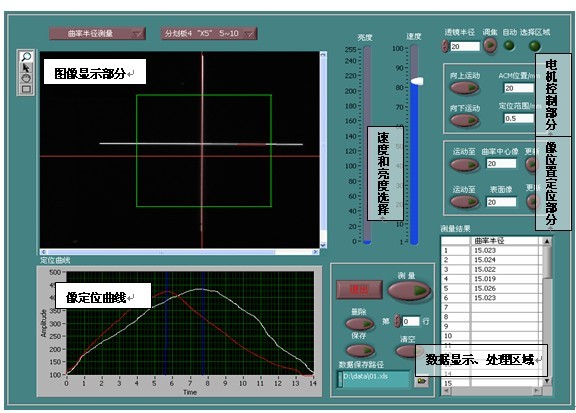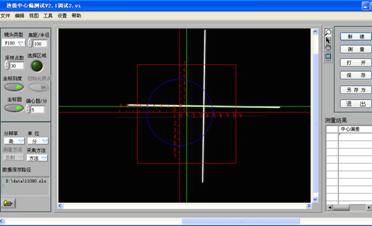|
FW-MT series is a high-precision lens (or lens group) of the spherical composite indicator measuring instrument, it is a non-contact manner without damage to achieve measurement of a lens (or lens group) radius of curvature and eccentricity exact focal length measurements. Specialized software designed to make quick simplistic actual measurement, data acquisition, automation and can calculate the results. Repeat the measurement accuracy, the specific operating requirements of low skill. Lens processing can be used to control the processing and shipping detection indicator, the lens assembly of the single-lens function indexes feed detection and precise monitoring of assembly accuracy. FW-MT series based on the measurement range is divided into different FW-MT50, FW-MT40, FW-MT30 three, widely used in the lens manufacturer, lens manufacturers use precision measuring instruments. Product Features: ◆ automated measurement, easy to use, simple operation, high efficiency measurement; ◆ high accuracy, powerful, wide measurement range; ◆ Device strong security, reliability, high durability; ◆ user-friendly, fully functional test software, the measurement visualize, and can be obtained directly test value; Measuring the radius of curvature:
The radius of curvature of the spherical information reflects the single most important indicator of the sphere is the need to control the direct process parameters. The radius of curvature of the processing control precision lens focal length directly affect the function parameters. Integrated measuring instrument is no damage to the non-contact measurement methods to accurately measure the radius of curvature, eliminating the traditional model for better processing controls may damage the lens risks and needs the step of pre-production of precision model. The measurement principle and random measurement software as described below. Principle and Operation Introduction:
The radius of curvature is measured using a reflective state. High quality CCD camera, respectively, and the center of curvature lens surface reflection focusing imaging, focus position is determined by the test software for CCD image acquisition crosshair scale data for accurate and calculated. Shown on the right, respectively convex surface of the lens and the center pixel as the image position, the lens is equal to the radius of curvature of the measurement surface of the distance between the two positions.
The radius of curvature measurements are automated, but the first piece of software interface measurements need to click on the "upward movement" or "downward" button to move the photoelectric autocollimator find surface like the location and the location of the center of curvature like (ie software image display area appears crosshairs like), and press the "Update" reflects the position value. Then just put the pieces need to be measured by a lens, press the "Measure" button, electric translation stage driven by photoelectric autocollimator movement automatically measure and display the results box shows the measurement results of each piece. Meanwhile, the curve shows two boxes will display the location curve.  Focal length measurement Focal length measurement
Focal length of the lens design is the most important indicator, although it can not be directly controlled in the process, but it reflects the curvature of each surface, including the material and thickness of comprehensive information. Focal length of the lens directly affect the accuracy of the actual use of the functions. Focal length of the different positions depending on the calculation, and can be divided into the effective focal length (EFL), back focal length (BFL), before the focal length (FFL), which is slightly different measurement principle.
 Principle and Operation Introduction: Principle and Operation Introduction:
Effective focal length refers to the corresponding optical main focal plane distance, the measurement method is transmissive mode, dual vertical crosshair through the collimator, testing lens, achromatic objective lens and optical autocollimator lens, the CCD into double vertical image. Measurement software to control the electric translation stage accurately focus on the image, and according to the captured images are automatically calculated Teseq lens focal length.
Focal length of the lens optical surface around the apex to the corresponding focal distance, the measurement method of measuring the radius of curvature similar to the system surface of the lens respectively detecting part (reflection method) and the focal plane (transmission method) focusing imaging, the focus position is determined by the test software for CCD image acquisition crosshair scale data for accurate and calculated before and after the focal length equal to the distance between the two locations.
Focal length measurements, the operator need to select "Focus Measure" software options, and according to the scope of testing lens focal length lens and reticle selection type, photoelectric autocollimator adjust the position of the screen to find clear double vertical line crosshair like, you can get the value of the focal length, the result will be displayed in the display box sequence.
Measurement software:
Measurement software designed to make specific measurements simple and intuitive, automatic operation, and can record measured values and allows direct processing of measured data. Specific software interface as shown below, including the image display section, data display and processing section, motor control section and can display surfaces like location targeting and centers like curves, and measuring the parameters required button. Comparison of the measurement precision Integrated measuring instrument can also be used as comparison of precision goniometer used, applies to some particular side of the vertical measurement of the lens, and some angle planar element, parallel, side-down measurement, and precision angular alignment of the assembly system so . The measurement principle is the principle of the use of a collimator, located on the back focal plane of the collimator lens illuminated reticle is projected to infinity, after being reflected by the mirror, and then by a collimating lens imaging in high-precision CCD industrial camera photosensitive surface . Since the collimator angle between the optical axis and the mirror will cause small changes in the location of the cross as the deviation of the system of this deviation can be very accurately measured and converted into the required angle measured values. 
Measuring the center deviation
Eccentric (or central side) on the lens assembly and application functionality plays a vital role, a lens (or lens group) refers to the optical axis of the eccentric shaft do not coincide with the reference optical axis with the position or direction of the reference axis deviation. Measuring a lens (or lens group) method is usually to make the eccentric rotation of the sample, by adding a lens configuration of a rotation device, integrated measuring instruments can be used as the eccentricity precision measuring instrument, and also has a transmission or reflection measurement modes, the measurement accuracy can reach 0.2um accuracy.
 Principle and Operation Introduction: Principle and Operation Introduction:
Parallel light incident (transmitted or reflected) through the sample after the crosshairs in its focal plane imaging like (or curvature center) on. Precision industrial CCD cameras to capture images crosshairs, and a lens like the beating caused by the rotation. Re-use test software accurately calculate crosshairs like beating size to calculate the size of the DUTs eccentric. Thanks to the systems precision-engineered and precision, the actual operation is very convenient eccentric test: According to the focal length of the sample selection lens, the lens sample is placed in the sample stage (following figure), adjust the V-shaped bracket to the lens side full contact. Rotary wheel drive with a rubber V-shaped lens of the reference rotation, CCD camera image can be continuously collected reticle, illustrated as following test software is automatically calculated by the cross on the focal plane of the lens as the radius and angle corresponding to the beat (ie: Lens eccentricity value).
The main application: ◆ radius of curvature measurement;
◆ effective focal length measurement;
◆ front focal length measurement;
◆ center deviation measurement;
◆ angle comparison of the measurement;
|